April 2022 LIP of the Month
Alborz Large Igneous Province (Alborz LIP): A new LIP and a robust candidate for the Late Ordovician mass extinction (LOME)
Morteza Derakhshi 1, Richard E. Ernst 2,3, Sandra L. Kamo 4
1 Department of Geology, Urmia Branch, Islamic Azad University, Urmia, Iran
e-mail: mortezaderakhshi78@yahoo.com
2 Department of Earth Sciences, Carleton University, Ottawa, ON K1S 5B6, Canada
3 Faculty of Geology and Geography, Tomsk State University, 36 Lenin Ave, Tomsk 634050, Russia
4 Jack Satterly Geochronology Laboratory, Department of Earth Sciences, University of Toronto, 23 Ursula Franklin St., Toronto, ON M5S 3B1, Canada
Extracted and modified from:
Derakhshi, M., Ernst, R.E., Kamo, S.L. (2022). Ordovician-Silurian volcanism in northern Iran: Implications for a new Large Igneous Province (LIP) and a robust candidate for the Late Ordovician mass extinction. Gondwana Research. 107, 256-280. https://doi.org/10.1016/j.gr.2022.03.009
The Late Ordovician mass extinction (LOME), as the first global extinction and the second-largest one of the ‘‘big five”, is typically considered to have had two distinct pulses. In recent years, a growing body of chemostratigraphic records (such as mercury and Hg/TOC anomalies and isotopic carbon excursions) suggests that multiple phases of an obscure Large Igneous Province (LIP) were the driver of climatic and environmental changes that ultimately led to the LOME.
Derakhshi et al. (2022) provides a body of evidence to support northern Gondwana as the birthplace of a new LIP, with the name Alborz LIP, which can be considered as the main cause for triggering environmental and climate changes during the Middle Ordovician to early Late Silurian.
Northern Iran experienced a period of widespread and intense rift-related volcanic activity during the Middle Ordovician to Silurian (Fig. 1). This chain of volcanic events was in relation to the process of initial continental rifting and break-up of the northern margin of Gondwana, which led to the creation of the Paleotethys Ocean.
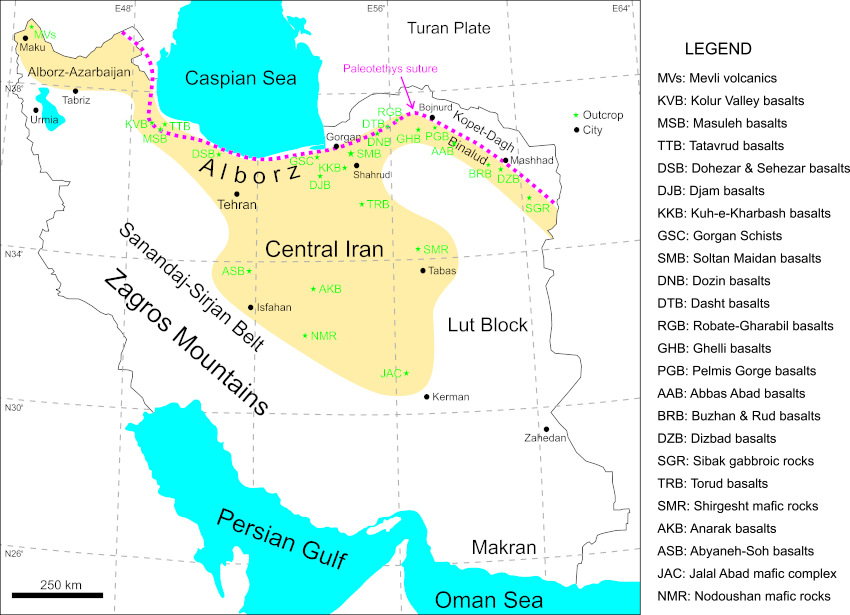
Fig. 1. Distribution of Ordovician-Silurian igneous rocks in Iran.
Derakhshi et al. (2022) based on fieldwork, relative ages, and high precision U-Pb ID-TIMS dating results have documented seven major magmatic phases of mostly short duration, including four phases (P1 to P4) for the Middle to Late Ordovician and three phases (P5 to P7) for Silurian. Most of these magmatic phases are basaltic (to andesitic) and in some places reach over 1000 m in total thickness (Table 1). These volcanic rocks are generally alkaline or transitional to mildly alkaline in nature and were erupted in a continental within-plate (or intraplate) setting. In addition, geochemical data from mafic rocks of northern and Central Iran on discrimination diagrams of Pearce (2008; Figs. 2a & b) as well as LIP printing diagram of Pearce et al. (2021; Fig. 2c) demonstrate an OIB pattern similar to many typical continental LIPs.
Table 1. Summary of information and data for studied volcanic events and their samples.
|
Volcanic event |
Sample No. |
Structural zone/subzone |
Rock type |
Thickness (m) |
Volcanic structure/state |
|
SMBC (Cheshmeh-Seyed Valley) |
- |
Eastern Alborz |
Basaltic |
1176 |
Massive, columnar, agglomerate, tuff |
|
SMBC (Khoshyeilaq area) |
- |
Eastern Alborz |
Basaltic |
>832 |
Massive, columnar, agglomerate, tuff, pillowed |
|
Mevli basalts |
- |
Alborz-Azarbaijan |
Basaltic |
>500 |
Massive, agglomerate, apophysis, dyke, sill |
|
Mevli rhyolites |
MD19-IKR |
Alborz-Azarbaijan |
Rhyolitic |
>700 |
Massive, agglomerate, tuff |
|
Buzhan & Rud basalts |
MD19-NMB |
Binalud |
Basaltic |
ca. 300 |
Massive, columnar, agglomerate, apophysis, dyke, pillowed? |
|
Pelmis Gorge basalts |
- |
Binalud |
Basaltic |
223 |
Massive, agglomerate, pillowed |
|
Robate-Gharabil basalts |
- |
Binalud |
Basaltic |
ca. 40 |
Massive, agglomerate, dyke |
|
Dasht basalts |
MD19-DHT |
Binalud |
Basaltic |
ca. 100 |
Massive, agglomerate |
|
Kolur Valley basalts |
- |
Western Alborz |
Basaltic |
>300 |
Massive, agglomerate, dyke |
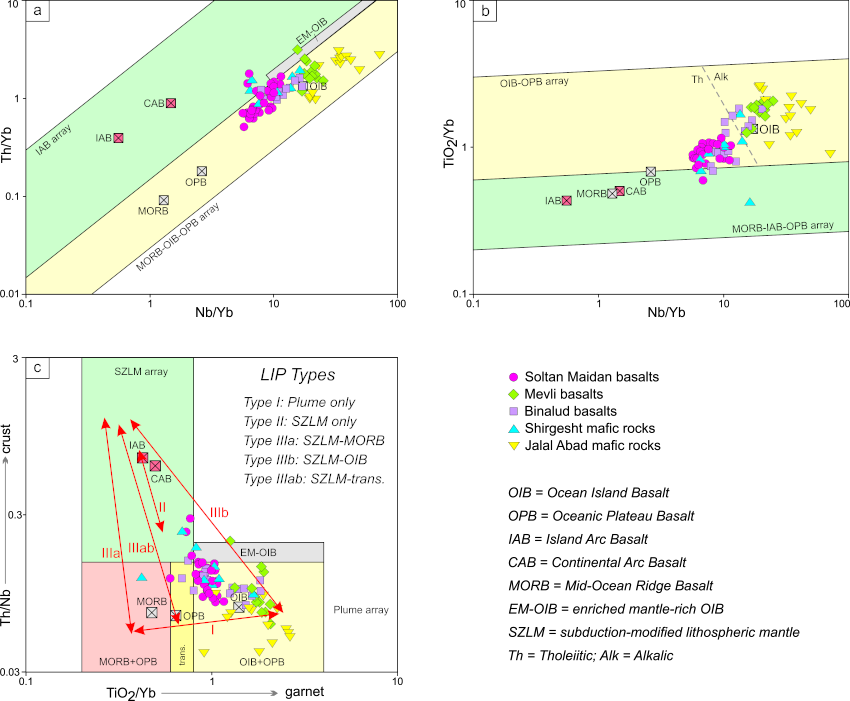
Fig. 2. Using (a) Th/Yb-Nb/Yb and (b) Ti/Yb-Nb/Yb diagrams (after Pearce, 2008) and (c) the LIP printing diagram designed by Pearce et al. (2021) to show the source of magmatic rocks of northern and Central Iran and their relationships with the LIPs. Data sources for Ordovician-Silurian basaltic rocks of the Soltan Maidan (Derakhshi, 2014; Derakhshi and Ghasemi, 2015; Derakhshi et al., 2017), Mevli (Valinasab Zarnagh et al., 2021), and Binalud Mountains (Arbabi Tehran et al., 2010) are from northern Iran. The other two published datasets for mafic rocks of the Shirgesht area (Derakhshi et al., 2006; Ghasemi and Derakhshi, 2008) and Jalal Abad mafic complex (Vesali et al., 2020) from Central Iran Zone are also shown for comparison.
The chain of volcanic events in northern Iran began in the earliest Darriwilian (i.e. phase P1, 468.70±0.30 Ma, early Middle Ordovician, Figs. 3-5) and a few million years before the beginning of a global sharp drop in seawater 87Sr/86Sr ratio. An approximate coincidence between the onset of the basaltic volcanism/weathering in phase P1 and the significant global decline in seawater 87Sr/86Sr during the Darriwilian Stage may be a sign of the early stages of the formation of the Alborz LIP.
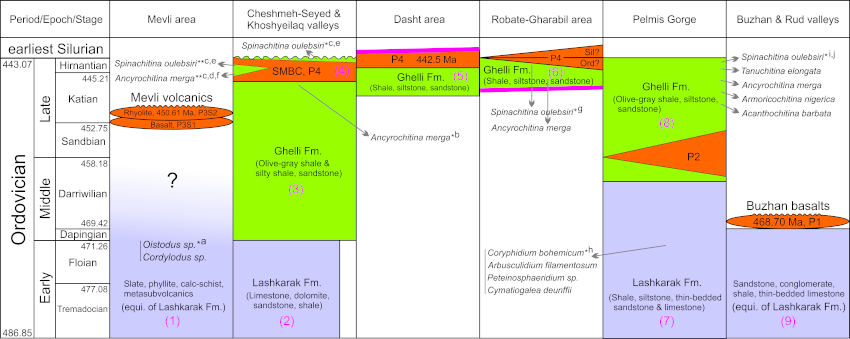
Fig. 3. Schematic lithostratigraphic columns illustrating Ordovician to earliest Silurian sections of the studied areas from northern Iran. The vertical scale (in Ma) is from Goldman et al. (2020). The relative ages of stratigraphic units are from: (1) = Berberian and Hamdi, 1977*a, (2, 3) = Ghavidel-Syooki and Khandabi, 2013*b, (4) = Ghavidel-Syooki et al. 2011*c; Derakhshi, 2014*d; Mahmoudi et al. 2014*e; Derakhshi et al. 2017*f, (5) = Derakhshi et al. (2022), (6) = Ghavidel-Syooki and Borji, 2018*g, (7) = Ahmadzadeh-Heravi, 1983; Ghavidel-Syooki, 2000*h, (8) = Afshar-Harb, 1979; Ghavidel-Syooki, 2000, 2017a*i, 2017b; Ghavidel-Syooki and Winchester-Seeto, 2002*j), (9) = Derakhshi et al. (2022).
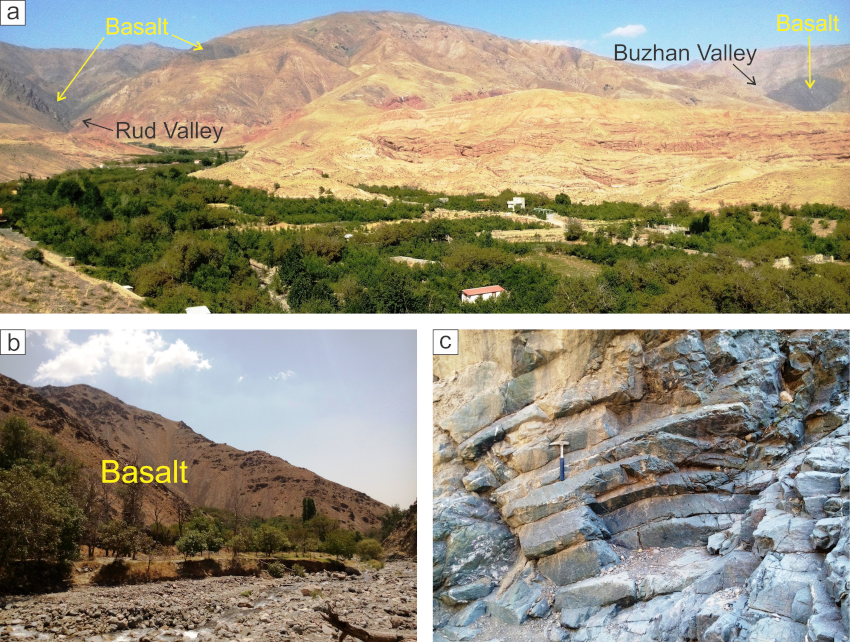
Fig. 4. (a) A general view of Buzhan & Rud valleys in the Binalud Mountains. (b) A view of some parts of the basaltic lava flows from the Buzhan Valley and (c) a photograph of well-developed columnar jointing from the Rud Valley. These basaltic rocks belong to the first phase of volcanism (i.e. phase P1) of the Alborz LIP.
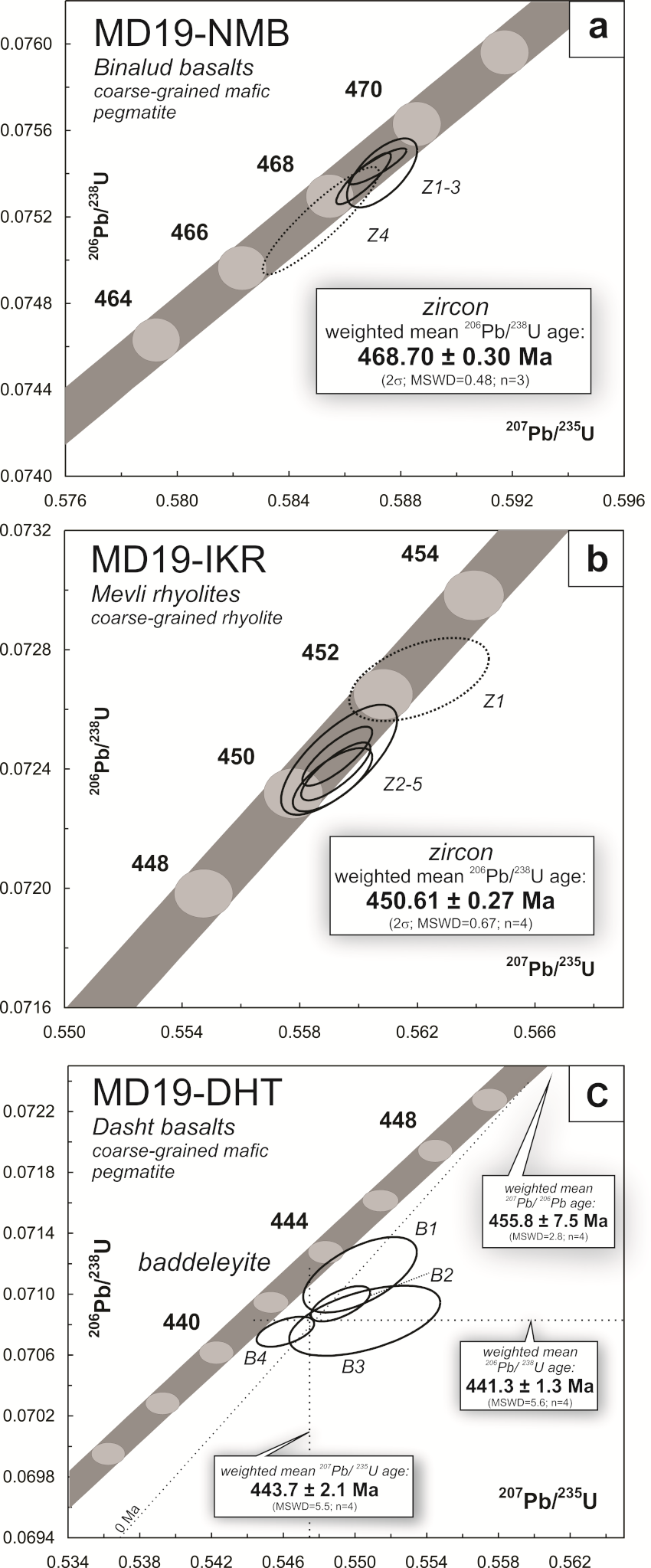
Fig. 5. U-Pb concordia diagrams showing zircon and baddeleyite results from the (a) Buzhan basalts (phase P1), (b) Mevli rhyolites (phase P3), and (c) Dasht basalts (phase P4).
The enormous volcanic eruptions in phase P3, with more than 1200 m of basaltic-rhyolitic lava flows and an age between the Sandbian-Katian boundary and 450.61±0.27 million years ago (Figs. 3 & 5), can be considered to mark the beginning of an increase in volcanic intensity. The occurrence of this huge bimodal volcanic activity may have been a prelude to the main phase of volcanism and also profound global environmental and climate changes of the Late Ordovician.
Evidence indicates that the climax of volcanism, with at least two very short stages of intensive basaltic eruptions in phase P4, occurred during the late Katian to around the Ordovician-Silurian boundary (Figs. 6 & 7). As shown in Fig. 8, this phase of volcanism coincides with the globally recorded Hg and Hg/TOC anomalies as well as the Hirnantian isotope carbon excursion (HICE).
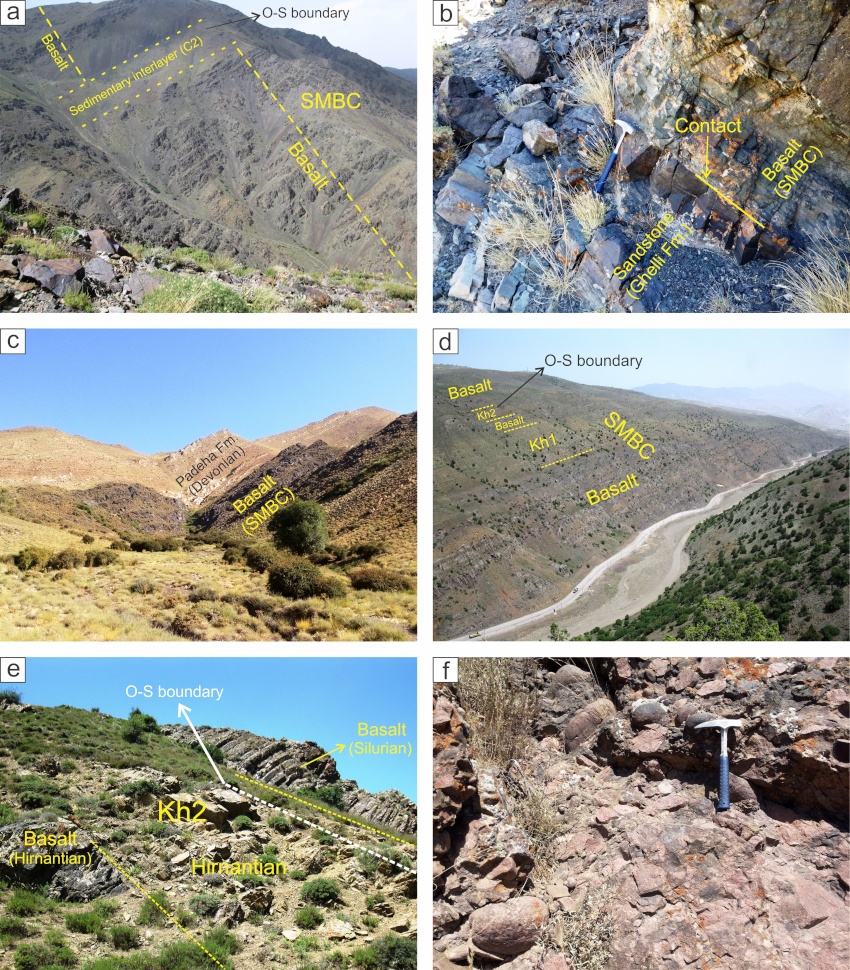
Fig. 6. (a) A general view of Soltan Maidan Basaltic Complex (SMBC) and (b) a view of the lower contact of this basaltic complex with the Ghelli Formation from the Cheshmeh-Seyed Valley. (c) The contact between the SMBC and Lower-Middle Devonian Padeha Formation in the Meighan Valley. (d) A general view of the lower part of SMBC in Khoshyeilaq Valley. (e) Ordovician-Silurian boundary within the Kh2 interlayer and (f) pinkish granitic clasts (of phase 5) within the conglomerate interlayer of Kh3 in the Khoshyeilaq area. It should be noted that SMBC, from the Alborz Mountain Range, is the most important and voluminous remnant of Ordovician-Silurian volcanic events in all of northern Iran. Moreover, four phases of the Alborz LIP, including P4 to P7, in different sections of this complex have been identified by Derakhshi et al. (2022).
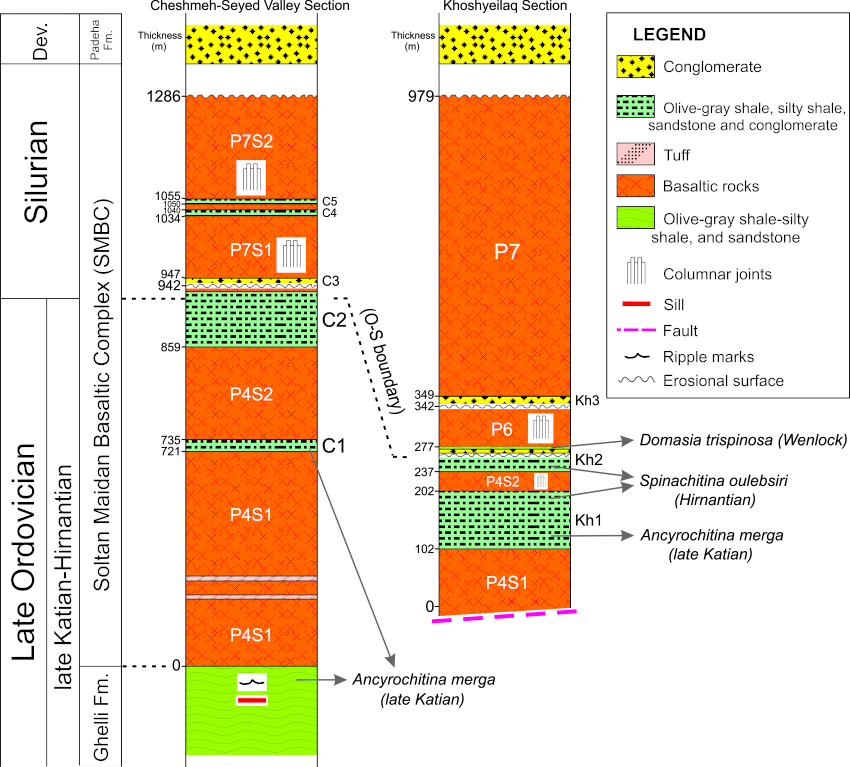
Fig. 7. Lithostratigraphic sections of the SMBC from Cheshmeh-Seyed Valley and Khoshyeilaq area (modified from Derakhshi, 2014, and Derakhshi et al., 2017). The white symbols, e.g., P7, show the volcanic phases. Palynomorph data for the Khoshyeilaq section adapted from Ghavidel-Syooki et al. (2011) and for the Cheshmeh-Seyed Valley section from Derakhshi (2014) and Derakhshi et al. (2017).
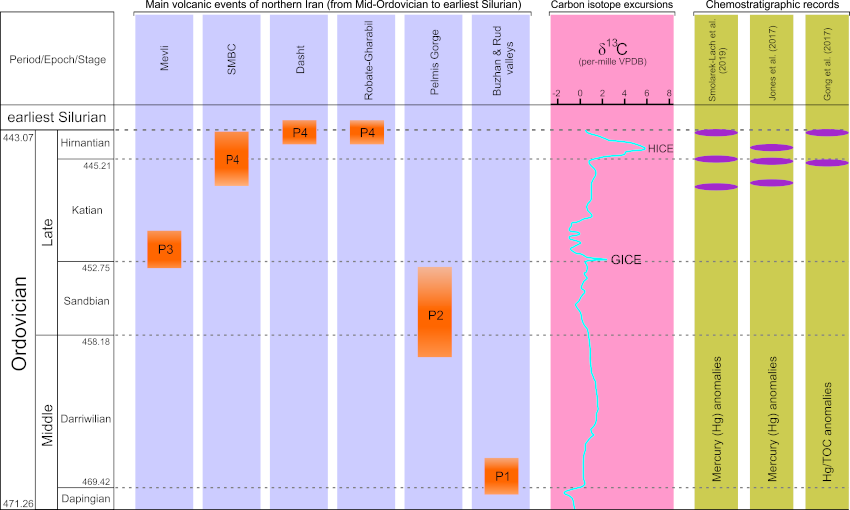
Fig. 8. A schematic comparison between main phases of Ordovician to earliest Silurian volcanism from northern Iran and carbon isotope curve (from Cramer and Jarvis, 2020) as well as notable Hg and Hg/TOC spikes documented by Jones et al. (2017), Gong et al. (2017) and Smolarek-Lach et al. (2019). VPDB: Vienna PeeDee Belemnite δ13C standard, GICE: Guttenberg Isotopic Carbon Excursion, HICE: Hirnantian Isotope Carbon Excursion. The vertical scale (in Ma) references as in Fig. 3.
This chain of volcanism continued with at least one granitic (phase P5) and two basaltic phases (of P6 & P7, Fig. 7) during the Silurian period and finally ended about 425 million years ago.
The results of Derakhshi et al. (2022) on the widespread and pulsatory volcanism of northern Iran can be a stimulus to think more deeply on a highly probable link between intense rift-related volcanism of the Paleotethys Ocean and the LOME. These results suggest that the magmatic rocks of northern Iran, and other related places, are the main remnants of the Alborz LIP. It appears that the high volume and very short duration of multiple pulses of Late Ordovician volcanism of this newly discovered LIP had enough potential for significant environmental and climate changes that ultimately led to the end-Ordovician mass extinction.
For full details see Derakhshi et al. (2022).
References
Afshar-Harb, A., 1979. The stratigraphy, tectonics and petroleum geology of Kopet-Dagh region, Northern Iran. Ph.D. Thesis, Petroleum Geology Section, Royal School of Mines, Imperial College, London. 316 p.
Ahmadzadeh-Heravi, M., 1983. Brachiopods and conodonts from Lower Palaeozoic sediments in southern Bojnourd. J. Technol. Sci. Tehran Univ. 45, 1-24. (in Persian)
Arbabi Tehran, M., Mehdizadeh Shahri, H., Fazel Valipour, M.E., 2010. The Geochemistry of Basalts in northeast of Darood Neyshaboor, NE Iran. The 1st International Applied Geological Congress, Department of Geology, Islamic Azad University-Mashad Branch, Iran, 26-28 April 2010.
Berberian, M., Hamdi, B., 1977. First discovery of Ordovician beds and conodonts in the slightly metamorphosed rocks of Kuh-e-Agh Baba. Maku Quadrangle map, Azarbaidjan: Iran Geol Surv Publ, Report No. 82.
Cramer, B.D., Jarvis, I., 2020. Chapter 11- Carbon isotope stratigraphy. In: Gradstein, F.M., Ogg, J.G., Schmitz, M.D., Ogg, G.M. (Eds.), Geologic Time Scale 2020, vol. 1. Elsevier, Amsterdam, pp. 309-343. https://doi.org/10.1016/B978-0-12-824360-2.00011-5.
Derakhshi, M., 2014. Petrology, geochemistry and geodynamic model of Soltan Maidan Basaltic Complex (SMBC), north of Shahrood. Doctoral dissertation, Shahrood University of Technology, Shahrood, Iran. 377 p. https://shahroodut.ac.ir/en/thesis/thesis.php?thid=QE209
Derakhshi, M., Ghasemi, H., 2015. Soltan Maidan Complex (SMC) in the eastern Alborz structural zone, northern Iran: Magmatic evidence for Paleotethys development. Arab. J. Geosci. 8, 849-866. https://doi.org/10.1007/s12517-013-1180-2
Derakhshi, M., Ghasemi, H., Taheri, A., Sadeghian, M., Heydarnia, H., 2006. Stratigraphic position, geochemistry and petrogenesis of Lower Paleozoic igneous rocks in Shirgesht area, northwest of Tabas. 10th conference of Geological Society of Iran, 4-6 September 2006, Tarbiat Modares University, Tehran, Iran. (in Persian)
Derakhshi, M., Ghasemi, H., Miao, L., 2017. Geochemistry and petrogenesis of Soltan Maidan basalts (E Alborz, Iran): Implications for asthenosphere-lithosphere interaction and rifting along the N margin of Gondwana. Chem Erde. 77 (1), 131-145. https://doi.org/10.1016/j.chemer.2017.01.002
Derakhshi, M., Ernst, R.E., Kamo, S.L. (2022). Ordovician-Silurian volcanism in northern Iran: Implications for a new Large Igneous Province (LIP) and a robust candidate for the Late Ordovician mass extinction. Gondwana Research. 107, 256-280. https://doi.org/10.1016/j.gr.2022.03.009
Ghasemi, H., Derakhshi, M., 2008. Mineralogy, geochemistry and role of olivine mechanical separation in generation of Lower Paleozoic igneous rocks in Shirgesht area, NW of Tabas, Central Iran. Iranian Journal of Crystallography and Mineralogy (IJCM). 16 (2), 207-224. (URL: https://www.scinapse.io/papers/2295810444)
Ghavidel-Syooki, M., 2000. Palynostratigraphy and palaeobiogeography of Lower Palaeozoic strata in the Ghelli area, northeastern Alborz Range of Iran (Kopet-Dagh region). J. Sci. I. R. Iran. 11 (4), 305-318. (URL: https://jsciences.ut.ac.ir/article_31829.html)
Ghavidel-Syooki, M., 2017a. Cryptospore and trilete spore assemblages from the Late Ordovician (Katian-Hirnantian) Ghelli Formation, Alborz Mountain Range, Northeastern Iran: Palaeophytogeographic and palaeoclimatic implications. Rev. Palaeobot. Palynol. 244, 217-240.
Ghavidel-Syooki, M., 2017b. Stratigraphic evidence for Hirnantian glaciation in the Alborz Mountain Ranges, northeastern Iran. Palaeogeogr. Palaeoclimatol. Palaeoecol. 485, 879-898.
Ghavidel-Syooki, M., Winchester-Seeto, T., 2002. Biostratigraphy and palaeogeography of Late Ordovician chitinozoans from the northeastern Alborz Range, Iran. Rev. Palaeobot. Palynol. 118, 77-99.
Ghavidel-Syooki, M., Khandabi, M., 2013. Palynostratigraphy and Palaeogeography of Lashkarak and Ghelli formations from the Abarsaj area, NW Shahrud. Stratigraphy and Sedimentology Researches. 28 (4), 35-58 (in Persian)
Ghavidel-Syooki, M., Borji, S., 2018. Chronostratigrahy of Acritarchs and Chitinozoans from upper Ordovician Strata from the Robat-e Gharabil Area, NE Alborz Mountains, Northern Khorassan Province: Stratigraphic and Paleogeographic Implications. J. Sci. I. R. Iran. 29 (1), 35-51.
Ghavidel-Syooki, M., Hassanzadeh, J., Vecoli, M., 2011. Palynology and isotope geochronology of the Late Ordovician-Silurian successions (Ghelli and Soltan Maidan Formations) in the Khoshyeilagh area, eastern Alborz Range, northern Iran; stratigraphic and palaeogeographic implications. Rev. Palaeobot. Palynol. 164, 251-271.
Goldman, D., Sadler, P.M., Leslie, S.A., Melchin, M.J., Agterberg, F.P., Gradstein, F.M., 2020. Chapter 20- The Ordovician Period. In: Gradstein, F.M., Ogg, J.G., Schmitz, M.D., Ogg, G.M. (Eds.), Geologic Time Scale 2020, vol. 2. Elsevier, Amsterdam, pp. 631-694. https://doi.org/10.1016/B978-0-12-824360-2.00020-6
Gong, Q., Wang, X., Zhao., L., Grasby, S.E., Chen, Z.Q., Zhang, L., Li, Y., Cao, L., Li, Z., 2017. Mercury spikes suggest volcanic driver of the Ordovician-Silurian mass extinction. Scientific Reports. 7, 5304. https://doi.org/10.1038/s41598-017-05524-5
Jones, D.S., Martini, A.M., Fike, D.A., Kaiho, K., 2017. A volcanic trigger for the Late Ordovician mass extinction? Mercury data from south China and Laurentia. Geology 45, 631-634.
Mahmoudi, M., Sabouri, J., Alimohammadian, H., Majidifard, M,R., 2014. The first report of cryptospore assemblages of Late Ordovician in Iran, Ghelli Formation, Eastern Alborz. Geopersia 4 (2), 125-140
Pearce, J.A., 2008. Geochemical fingerprinting of oceanic basalts with applications to ophiolite classification and the search for Archean oceanic crust. Lithos 100, 14-48.
Pearce, J.A., Ernst, R.E., Peate, D.W., Rogers, C., 2021. LIP printing: Use of immobile element proxies to characterize Large Igneous Provinces in the geologic record. Lithos 392-393. https://doi.org/10.1016/j.lithos.2021.106068
Smolarek-Lach, J., Marynowski, L., Trela, W., Wignall, P.B., 2019. Mass extinction event: An example from a Deep shelf of the peri-Baltic Region. Sci. Rep. 9, 3139.
Valinasab Zarnagh, F., Moayyed, M., Jahangiri, A., Azizi, H.H, 2021. Magma source and the evolution of Early Paleozoic (Silurian) metavolcanic rocks of Maku area (northwest of Iran): An evidence for Paleotethys drifting. Iranian Journal of Petrology. 12 (1), 19-40. (in Persian) http://dx.doi.org/10.22108/ijp.2020.121834.1166
Vesali, Y., Esmaeily, D., Moazzen, M., Chiaradia, M., Morishita, T., Soda, Y., Sheibi, M., 2020. The Paleozoic Jalal Abad mafic complex (Central Iran): Implication for the petrogenesis. Chem Erde. 80 (1), 125597. https://doi.org/10.1016/j.chemer.2020.125597
